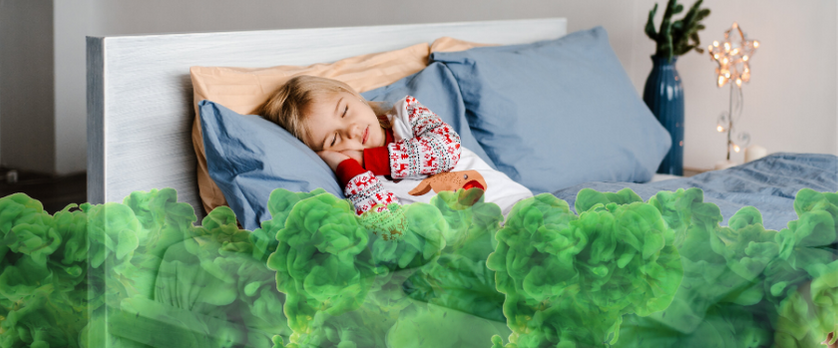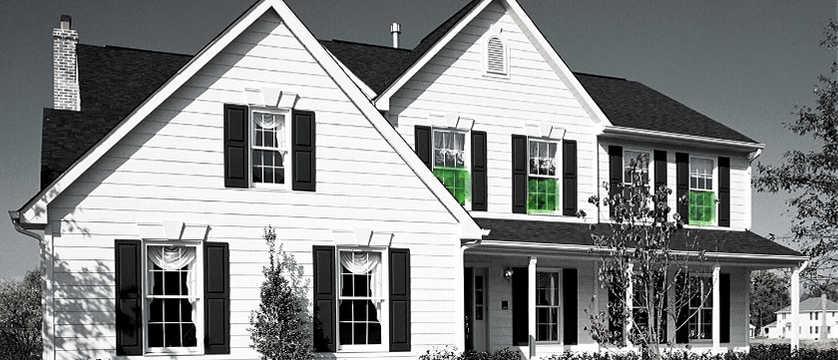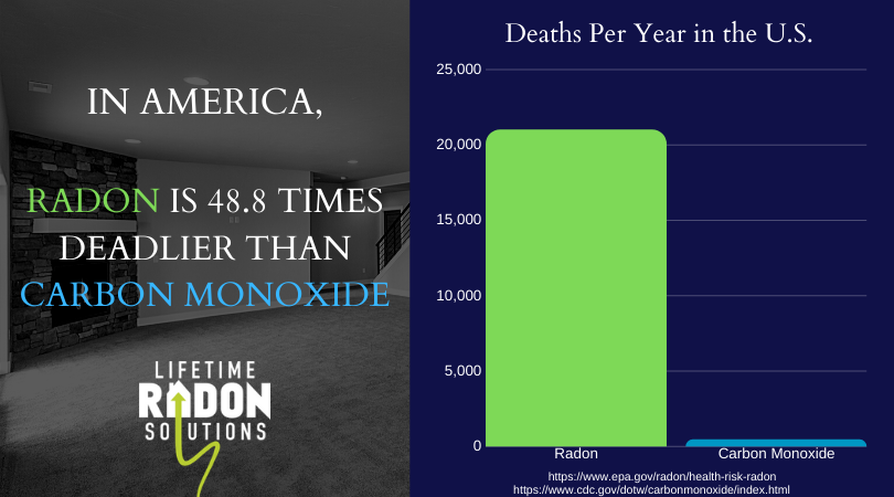|
If you are not familiar with the harmful effects of radon gas, you are not alone. In our experience, around half of the people that have called into our company, or have met us at various trade shows, have not heard of radon or its harmful effects until they decided to sell their home. Radon testing and mitigation are very commonly associated with real estate transactions because of how few homes are tested for radon prior to a home inspection. Radon testing being included as part of a home inspection is a fairly recent development, so most homes that have been lived in for a long period of time probably have never been tested for radon. This is, unless the owner of the home took it upon themselves to get a radon test kit or have a company come out and test their home for radon. With little awareness and education out there about radon (currently the federal radon program is defunded), many people get rightly confused or angry about the possibility of having to install a radon mitigation system on the home they are selling. In this article, we want to not only raise awareness about the harmful effects of radon gas, but also encourage everyone to have their home tested for radon even if one doesn't plan on selling or buying a new home. With that being said, here are a few reasons you should start caring about radon: 1. RADON GAS IS KNOWN TO CAUSE LUNG CANCERRadon gas is a Class A carcinogen, meaning it is known to cause cancer in humans (lung cancer specifically). Radon decays at a fast rate and gives off small radioactive particles that can attach themselves to things like moisture or dust in the air. When inhaled, over a long period of time, this can cause damage to the cells that are in the lining of the lungs. Radon is the leading cause of lung cancer among non-smokers and can affect anyone. No matter your age, race, or prior medical conditions you can be susceptible to the harmful effects of radon. Out of the five main causes of lung cancer which include smoking, radon gas, asbestos, pollution, and genetics; radon gas ranks second only to smoking in the number of lung cancer cases caused. If you are a smoker, your odds of getting lung cancer are increased substantially if your home has an elevated radon level. At Lifetime Radon Solutions, we feel that the possible health effects radon can cause is more than enough of a reason to have your home tested. Radon testing is easy and affordable to do. 2. PETS ARE AFFECTED BY RADON GAS TOOHumans are not the only ones who can get lung cancer from elevated radon levels in their home. In fact, household pets can be more susceptible to the ill effects of elevated radon levels in a home because of their higher respiratory rate, and their propensity to be low to the ground (where radon levels are at their highest). Many cats and dogs love to hang out in the basement and even sleep down there. Due to radon’s tendency to build up in the lowest level of the home, this can cause significant harm to your pets if they are exposed for lengthy periods of time. Unfortunately, we have heard of many cases where a family’s beloved pet developed lung cancer likely due to radon exposure. Taking action by properly testing your home and installing a radon mitigation system if necessary can not only protect your own health, but the health of your furry friends as well. 3. HOMEOWNERS ARE NOT THE ONLY ONES AFFECTEDIt is a common misconception that radon gas can only build up in residential homes and smaller structures. Radon gas can become trapped in any structure, no matter how large. We have received elevated radon test results from apartments, condos, office buildings, storefronts, factories, and schools. Fortunately, even large buildings can be mitigated to a safe level. The unfortunate part is, many times these types of buildings are not tested or mitigated. If you live, work, or go to school in one of these larger structures, it is important to ask the owner of the building if they have conducted a radon test in the past. If they have not, you should request that one be done. You can personally test your apartment, or condo with a charcoal testing kit or have a company like Lifetime Radon Solutions bring in a digital testing monitor. However, if mitigation is necessary, the owner of the building must approve of the system being installed on their property. 4. HAVING BEDROOMS OR EXERCISE ROOMS IN YOUR BASEMENT MAY PUT YOU AT A HIGHER RISKWe believe it is necessary to test your home no matter how it is constructed. However, it is especially important to take action if you have a bedroom or exercise area in the lowest level of your residence. If you sleep downstairs, you could possibly be consistently breathing in elevated radon levels for 6-10 hours every single night. As for having an exercise room in the basement, staying healthy by working out could end up being counterproductive if you are doing it in an area that has dangerous levels of radon gas. Your increased respiratory rate from exercising paired with being low to the ground during certain exercises such as push-ups, sit-ups, yoga, etc. can put you at a higher risk than normal. If you have either a bedroom or an exercise room in your basement, we would highly suggest installing a radon mitigation system no matter what. 5. RADON LEVELS CAN BE ELEVATED ON UPPER FLOORS AS WELL; NOT JUST IN THE BASEMENT.“Why should I test my basement if it's rarely used?” We hear this statement a lot from the general public regarding testing their home for radon. While there is generally a smaller risk of radon exposure if you don’t use your basement, this isn’t always the case. Some homes can have such a high concentration of radon gas in the lowest level of the home that the radon levels on the next floor can creep up into the danger zone as well. This is why we urge every single homeowner to perform a radon test no matter how the home is built or used. We have seen some extremely high radon test readings in the past from homes with unfinished basements, and many of them have tested high on the main floor as well after further examination. Our motto is “Why Risk It?” because there is no reason to risk radon exposure when radon testing is extremely affordable and fast. In conclusion, we at Lifetime Radon feel that radon awareness is very important. Whatever your reason is, whether it be your health, your family's health, your pet’s health, or to increase the value of your home, TEST YOUR HOME FOR RADON! You will not regret it. Stay safe everyone! Andrew KreklowLifetime Radon Solutions
3 Comments
We have had a lot of concerned homeowners call us and ask questions about the health effects that they may experience after living in a home with elevated levels of radon gas. The term “radon poisoning” seems to come up a lot in their questions. For instance, “What is radon poisoning?” or “What symptoms are involved in radon poisoning?” To be clear, it’s not really poisoning that is occurring in your body when you are exposed to elevated radon levels. As radon-222 decays (it has a half life of approximately 3.8 days) radon produces what is known as radon daughter particles, which can attach to, or “plate on to,” things like water vapor, dust, pet dander or smoke in the air. When inhaled, over an extended period of time, these radioactive particles can damage the cells in your lungs and ultimately cause lung cancer. Similar to asbestos, radon typically takes years of exposure to cause cancer. Unfortunately, this causes a lot of people to put off having radon removed from their homes. Simply because radon gas is not usually an imminent concern or danger, does not mean it shouldn’t be addressed quickly. Most of us spend the majority of our time at home, so being exposed to dangerous radon levels for years is pretty easy to accomplish, especially if no action is taken. The majority of homeowners have at least one carbon monoxide detector in their home, which is great, but what most people don’t know is that radon gas causes approximately 20,500 more deaths per year than carbon monoxide does! Similarly, everyone should also have a smoke alarm in their home, and while that is extremely important, deaths from house fires in the U.S. in 2018 were 3,655 while radon related lung cancer deaths were estimated at between 21,000 and 29,000 that same year. If everyone is willing to purchase a carbon monoxide detector or smoke alarm for their home, what is holding them back from purchasing a radon test kit? What are the symptoms of radon exposure?Radon is a noble gas, which means it cannot be detected by any of our human senses. So we won’t be able to feel the effects of elevated radon levels until it’s too late. The only way to detect radon in a home is to do proper radon testing (which you can read about HERE). The symptoms of radon exposure will only be felt if you develop lung cancer from it. Here are some of the symptoms of lung cancer caused by radon gas exposure:
Many of these symptoms only occur in the advanced stage of the cancer, so it is vital to reduce your risk of getting lung cancer as soon as you can. Therefore, as you can see, the symptoms of radon exposure are not as noticeable as say carbon monoxide exposure or chlorine gas exposure, however the end result can be just as deadly. Steps you can take to reduce your risk of radon exposure:
In conclusion, radon gas is not something you should ignore simply because it doesn’t have an instant impact. Be proactive in testing your home regularly and taking the proper steps to mitigate if your home tests high. If you have questions about radon testing, radon mitigation, or the impact of radon on your lung health, give us a call today! We have provided radon testing and mitigation services throughout the state of Wisconsin for over two decades. Even if you don’t live in Wisconsin, that’s ok! We’re happy to answer any and all of your questions regardless of where you reside! Andrew KreklowLifetime Radon Solutions Inc. |
AuthorBrian S. Thompson Archives
March 2023
|
- Home
-
Locations
- Lifetime Radon Mitigation Minneapolis
- Lifetime Radon Mitigation Milwaukee
- Lifetime Radon Mitigation Fond du Lac
- Lifetime Radon Mitigation La Crosse
- Lifetime Radon Mitigation Oshkosh
- Lifetime Radon Mitigation Eau Claire
- Lifetime Radon Mitigation Wausau
- Lifetime Radon Mitigation Green Bay
- Lifetime Radon Mitigation Janesville
- Lifetime Radon Mitigation Rochester
-
Services
- Radon Mitigation
- Radon Testing
- FREE Radon Testing
- Crawl Space Encapsulation
- Trichloroethylene (TCE)
- Commercial Radon Testing and Mitigation
-
Local Articles
>
- Lifetime Radon Mitigation Brookfield
- Lifetime Radon Mitigation Madison
- Lifetime Radon Mitigation Plymouth
- Lifetime Radon Mitigation Brooklyn Park
- Lifetime Radon Mitigation West Allis
- Lifetime Radon Mitigation Racine
- Lifetime Radon Mitigation Menomonee Falls
- Lifetime Radon Mitigation Muskego
- Lifetime Radon Mitigation Maple Grove
- Lifetime Radon Mitigation Greenfield
- Lifetime Radon Mitigation Franklin
- Lifetime Radon Mitigation Fitchburg
- Lifetime Radon Mitigation Whitefish Bay
- Lifetime Radon Mitigation Hartford
- Lifetime Radon Mitigation New Berlin
- Lifetime Radon Mitigation Shorewood
- Lifetime Radon Mitigation Blaine
- Lifetime Radon Mitigation Appleton
- Lifetime Radon Mitigation Whitewater
- Lifetime Radon Mitigation Cudahy
- Lifetime Radon Mitigation Germantown
- Lifetime Radon Mitigation Sun Prairie
- Lifetime Radon Mitigation Oak Creek
- Lifetime Radon Mitigation Coon Rapids
- Lifetime Radon Mitigation Beloit
- Lifetime Radon Mitigation Grafton
- Lifetime Radon Mitigation Cedarburg
- Lifetime Radon Mitigation Burlington
- Lifetime Radon Mitigation Caledonia
- Lifetime Radon Mitigation Richfield
- Lifetime Radon Mitigation Duluth
- Lifetime Radon Mitigation Brown Deer
- Lifetime Radon Mitigation Sussex
- Lifetime Radon Mitigation South Milwaukee
- Lifetime Radon Mitigation Middleton
- Lifetime Radon Mitigation Waunakee
- Lifetime Radon Mitigation Watertown
- Lifetime Radon Mitigation Mequon
- Lifetime Radon Mitigation Pleasant Prairie
- Lifetime Radon Mitigation Greendale
- Lifetime Radon Mitigation Wauwatosa
- Lifetime Radon Mitigation Glendale
- Lifetime Radon Mitigation Oregon
- Lifetime Radon Mitigation Port Washington
- Lifetime Radon Mitigation De Pere
- Lifetime Radon Mitigation Pewaukee
- Lifetime Radon Mitigation Oconomowoc
- Lifetime Radon Mitigation Manitowoc
- Lifetime Radon Mitigation Verona
- Lifetime Radon Mitigation Stevens Point
- Lifetime Radon Mitigation Fort Atkinson
- Lifetime Radon Mitigation Beaver Dam
- Lifetime Radon Mitigation Little Chute
- Lifetime Radon Mitigation Onalaska
- Lifetime Radon Mitigation Baraboo
- Lifetime Radon Mitigation Waupun
- Lifetime Radon Mitigation River Falls
- Lifetime Radon Mitigation Marshfield
- FAQ's
- Blog
- Meet the Team
- Contact
- Testimonials
- Privacy
Lifetime Radon Solutions, Inc.
Copyright © 2018
Copyright © 2018









 RSS Feed
RSS Feed